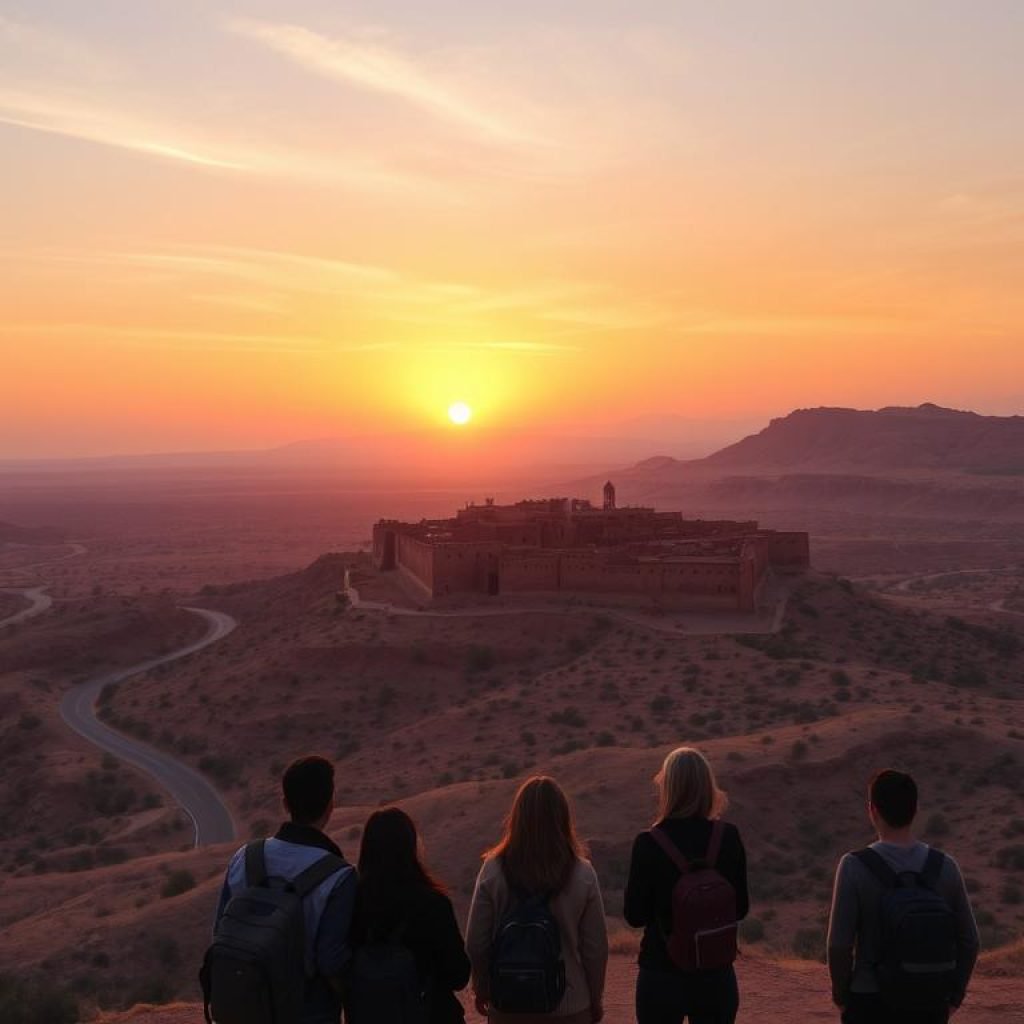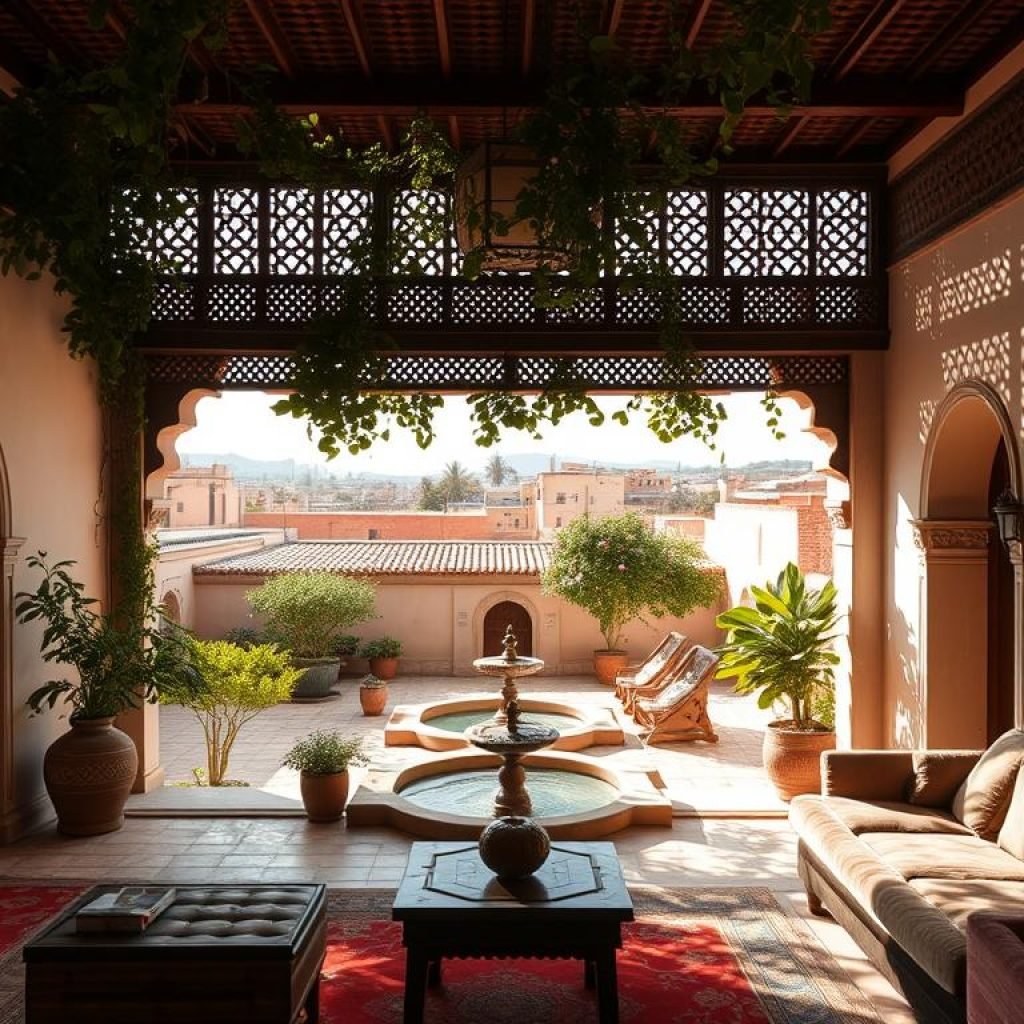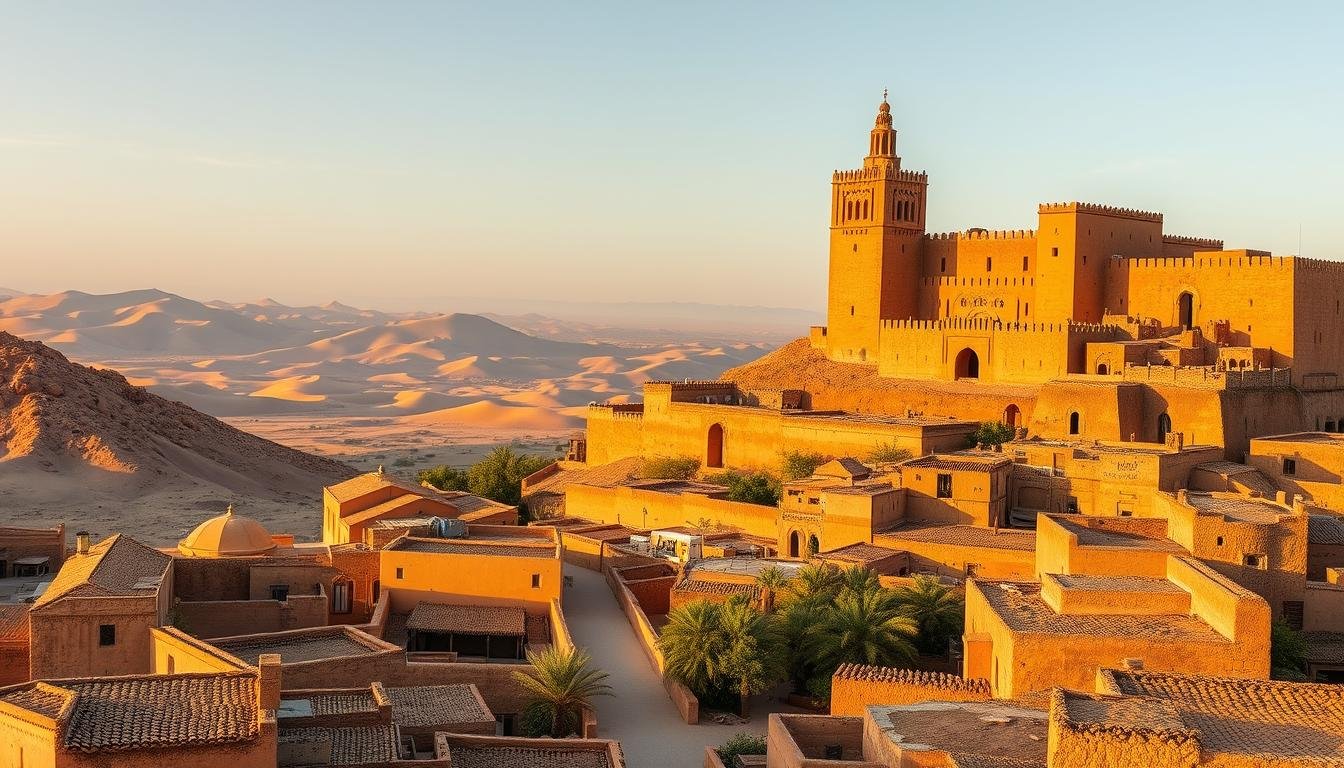Have you ever wondered what it’s like to step into a scene from your favorite movie? Imagine walking through ancient walls that have stood for centuries, where legends like Gladiator and Game of Thrones were brought to life. This is the magic of the historic site nestled in Morocco’s desert landscape.
This UNESCO World Heritage Site, built over a thousand years ago, is a masterpiece of mud and straw construction. It served as a vital stop along the caravan route, connecting the Sahara to Marrakesh. Today, it remains a symbol of Morocco’s rich cultural heritage and cinematic allure.
Whether you’re a history buff, a film enthusiast, or simply a curious traveler, this guide will help you uncover the secrets of this iconic destination. From its ancient origins to practical travel tips, we’ll ensure your visit is as memorable as the stories it has inspired.
Key Takeaways
- Discover a UNESCO World Heritage Site with over a thousand years of history.
- Explore a location featured in blockbuster films like Gladiator and Game of Thrones.
- Learn about the unique mud and straw construction of this ancient fortress.
- Get insider tips for planning a meaningful and hassle-free visit.
- Understand the cultural and cinematic significance of this iconic destination.
Discovering the Historic Charm of Ait Benhaddou Kasbah
Step into a world where history and cinema collide in a breathtaking desert landscape. This UNESCO World Heritage Site has not only preserved centuries-old traditions but also served as a backdrop for some of the most iconic films in history. From epic battles in Gladiator to the mystical allure of Game of Thrones, this site has captivated audiences worldwide.
Cinematic Legacy and UNESCO Heritage
The kasbah’s cinematic legacy is as rich as its history. Over the years, it has been featured in blockbuster films like The Mummy and Prince of Persia: The Sands of Time. Its unique architecture and dramatic lighting make it a favorite for filmmakers seeking authenticity and grandeur.
Designated a UNESCO World Heritage Site in 1987, this location is a testament to the enduring beauty of Moroccan culture. The preservation efforts ensure that visitors can experience the site as it has stood for centuries, a living museum of art and history.
Stories and Ancient Traditions
Beyond its cinematic appeal, the kasbah is a treasure trove of ancient traditions. Local families still reside here, preserving the customs and stories passed down through generations. The mudbrick buildings, designed to regulate temperatures, are a marvel of ancient engineering.
Visitors are often drawn to the site’s aesthetic beauty, especially during sunrise and sunset when the light creates a magical atmosphere. It’s not just a film set but a place where history comes alive, offering a glimpse into the authentic cultural life of Morocco.
| Film Location | Movie/TV Show | Year Released |
|---|---|---|
| Ait Benhaddou Kasbah | Gladiator | 2000 |
| Ait Benhaddou Kasbah | Game of Thrones | 2011-2019 |
| Ait Benhaddou Kasbah | The Mummy | 1999 |
Whether you’re a film enthusiast or a history buff, this site offers a unique blend of both. Its UNESCO status and cinematic legacy make it a must-visit destination for anyone exploring Morocco’s rich heritage.
Your Ait Benhaddou Kasbah guide
Exploring a cinematic landmark requires more than just showing up—it needs strategy. This guide is designed to help you make the most of your visit, whether you’re planning a quick day trip or a longer stay. With practical tips and insider knowledge, you’ll uncover the site’s hidden gems and cultural richness.
Time management is crucial when visiting a historically rich site. Many travelers opt for a day trip, but spending several hours allows you to fully appreciate its beauty and significance. From sunrise to sunset, the kasbah offers a unique experience that changes with the light.
Why This Guide Matters
This guide provides actionable insights to enhance your trip. It helps you balance sightseeing with immersive local experiences, ensuring you don’t miss out on the kasbah’s authentic charm. Whether you’re navigating self-guided tours or engaging with local traditions, the right guidance can transform your visit.
One of the challenges is managing your time effectively. With so much to see, it’s easy to feel rushed. This guide offers tips on optimizing your itinerary, so you can explore at your own pace and soak in every detail.
What sets this destination apart is its blend of history and cinematic allure. Unlike other tour spots, it’s a living testament to Morocco’s cultural heritage. By planning thoroughly, you’ll gain a deeper appreciation for its architecture, traditions, and stories.
Whether you’re visiting for a day or extending your stay, this guide ensures your experience is both meaningful and memorable. From practical advice to cultural insights, it’s your key to unlocking the essence of this iconic site.
Planning Your Journey to Morocco’s Iconic Kasbah
Planning a trip to Morocco’s iconic site involves more than just packing your bags. To fully appreciate its beauty and cultural significance, timing and preparation are essential. Whether you’re visiting for a day or staying overnight, understanding the best times to go and where to stay can make all the difference.

Best Times to Visit and Stay
The best time to visit is during spring (March to May) or fall (September to November). These seasons offer mild weather, perfect for exploring the site without the intense heat of summer. Early mornings or late afternoons are ideal for avoiding crowds and capturing the kasbah’s stunning lighting.
For a more immersive experience, consider spending a night in the region. Staying overnight allows you to witness the kasbah under the stars and enjoy the serene desert atmosphere. Local hotels and accommodations near the site provide a blend of comfort and authenticity, enhancing your visit.
Essential Cultural Insights
Understanding local customs is key to a respectful and enriching trip. Dress modestly, especially when interacting with residents, and be mindful of prayer times. Engaging with local traditions, such as sharing a meal with a Moroccan family, offers a deeper connection to the culture.
Aligning your visit with cultural festivals can also enrich your experience. Events like the Rose Festival in nearby Kelaat M’Gouna or traditional music performances add a vibrant layer to your journey. Plan ahead to ensure your dates coincide with these unique celebrations.
By blending historical exploration with local hospitality, your trip to Morocco’s iconic site will be both meaningful and unforgettable. With thoughtful planning, you’ll uncover the essence of this UNESCO treasure and create lasting memories.
Getting There: Transportation and Route Tips
Embarking on a journey to Morocco’s historic gem offers more than just a destination—it’s an adventure through time and terrain. Whether you’re starting from Marrakech or Ouarzazate, the route to this iconic site is as memorable as the destination itself. Here’s everything you need to know to make your trip seamless and scenic.
Traveling from Marrakech and Ouarzazate
From Marrakech, the journey spans approximately 100 miles and takes around four hours by car. The route winds through the Atlas Mountains, offering breathtaking views of rugged landscapes and traditional Berber villages. For those starting in Ouarzazate, the drive is shorter, covering just 18 miles and taking about 30 minutes.
Public transport options include buses operated by Supratours and CTM, with tickets costing around $10. Buses from Marrakech to Ouarzazate run multiple times daily, including night services. Once in Ouarzazate, shared taxis (Grand Taxis) are available for the final leg of the trip, costing approximately $1 per person.
Scenic Drives and Mountain Passes
The highlight of the journey is undoubtedly the Tizi n Tichka Pass, a winding mountain road that reaches an altitude of 7,415 feet. This pass is not for the faint-hearted, with sharp turns and steep drops, but the panoramic views of the Atlas Mountains make it worth the effort.
For those driving, renting a car in Marrakech costs around $32 per day. Be prepared for altitude changes and ensure your vehicle is in good condition. Along the way, take advantage of scenic stops like the Kasbah Glaoui in Telouet, a historic fortress built in the 1800s.
| Transport Option | Starting Point | Cost | Travel Time |
|---|---|---|---|
| Bus (Supratours/CTM) | Marrakech | $10 | 5 hours |
| Shared Taxi (Grand Taxi) | Ouarzazate | $1 | 10-15 minutes |
| Car Rental | Marrakech | $32/day | 4 hours |
Whether you choose public transport or a private car, the journey through the Atlas Mountains is an experience in itself. Plan your trip carefully, and don’t forget to stop and soak in the beauty of the atla regions along the way.
Where to Stay and What to Experience
Discover the perfect blend of comfort and culture near Morocco’s historic gem. Whether you’re seeking a luxurious retreat or a budget-friendly stay, the area offers a variety of accommodations to suit every traveler. From traditional riads to boutique hotels, your stay will be as memorable as the destination itself.

Accommodation Choices and Local Hospitality
For an authentic experience, consider staying in a traditional riad or a local guesthouse. These options often feature intricate Moroccan decor, courtyards, and rooftop terraces with stunning views. The Bagdad Café is a popular choice, offering a cozy atmosphere and warm hospitality.
If you prefer modern comforts, boutique hotels like Dar Mouna La Source provide a blend of luxury and tradition. Located just a short walk from the kasbah, it’s an ideal base for exploring the area. Families looking for a deeper cultural immersion can book accommodations that include Sahara Desert tours, offering activities like camel trekking and stargazing.
Exploring the Kasbah and Surroundings
The kasbah itself is a maze of narrow streets and ancient buildings, each telling a story of its rich history. Wander through the village to discover local markets, where artisans sell handmade crafts and traditional goods. The nearby town of Ouarzazate, known as the “Gateway to the Sahara,” is worth a visit for its film studios and cultural attractions.
Berber culture plays a significant role in the area’s charm. Many accommodations are family-run, offering guests a chance to experience authentic Moroccan hospitality. Enjoy traditional meals, learn about local customs, and immerse yourself in the daily life of the Berber community.
| Accommodation Type | Features | Best For |
|---|---|---|
| Traditional Riads | Courtyards, Moroccan decor, rooftop terraces | Cultural immersion |
| Boutique Hotels | Modern amenities, luxury, proximity to kasbah | Comfort and convenience |
| Guesthouses | Family-run, authentic meals, local experiences | Budget travelers |
Choosing the right place to stay can enhance your visit, offering both comfort and a deeper connection to the local culture. Whether you’re exploring the kasbah or venturing into the surrounding city and town, your accommodations will be a key part of your journey.
Insider Tips for an Authentic Ait Benhaddou Experience
Unlock the hidden treasures of this historic site by diving into its lesser-known corners. While the main attractions are breathtaking, the true magic lies in the way you explore. From secret viewpoints to local traditions, here’s how to experience the life and culture of this UNESCO gem like a true insider.
Local Secrets and Hidden Gems
Most visitors stick to the well-trodden paths, but the real charm lies in the valley beyond. Wander through the narrow alleys of the ksar to discover hidden courtyards and ancient structures. These spots offer a quieter, more intimate experience away from the crowds.
For a unique perspective, head to the less-explored areas of the aït. Local guides often recommend secret viewpoints that provide stunning panoramic views of the village and surrounding landscape. These spots are perfect for capturing unforgettable photos.
Engage with the locals to learn about their daily life. Many families still reside within the ksar, preserving centuries-old traditions. Respectful curiosity can lead to meaningful interactions, such as sharing a cup of mint tea or participating in a traditional meal.
Exploring the Valley and Beyond
The valley surrounding the site is a treasure trove of hidden gems. Take the time to explore the Ounila Valley, where you’ll find other well-preserved ksar structures like Anmiter. This area is often overlooked by day-trippers, making it a peaceful escape.
Timing your visit can also enhance your experience. Arrive early in the morning or late in the afternoon to avoid the crowds and enjoy the site’s serene atmosphere. If possible, plan your trip during spring or fall when the weather is mild, and the landscape is at its most vibrant.
Finally, don’t miss the chance to explore the local markets. These bustling hubs offer a glimpse into the life of the community, with artisans selling handmade crafts and traditional goods. It’s the perfect way to take a piece of this cultural heritage home with you.
Conclusion
Morocco’s historic gem offers a journey through time, blending cinematic allure with centuries-old traditions. From its UNESCO World Heritage status to its role in iconic films, this destination is a treasure trove of history and culture. The breathtaking view of the ancient structures against the desert backdrop is unforgettable.
Planning a trip from Marrakech is a rewarding experience, offering insights into the region’s rich heritage. Whether you’re captivated by its cinematic legacy or its architectural marvels, this site promises a memorable adventure. The benhaddou experience is more than just a visit—it’s a connection to Morocco’s past and present.
We invite you to explore this timeless destination and share your experiences. Bookmark this guide for future reference and leave your comments or questions. An organized trip ensures a richer, more fulfilling journey through Morocco’s cultural heart.




Comment (0)